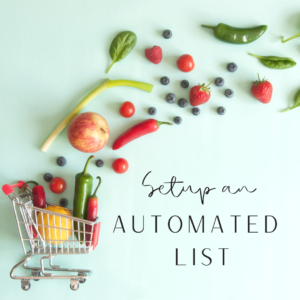Easy Tip to Reduce Germs, Time and Money

The COVID19 crisis taught me something I never saw coming. Something that has saved us a ton! Read on to learn an easy tip to reduce germs, time and money that is so crazy simple and actually involves SHOPPING!
Pre-COVID, we would make a weekly trip to the grocery store, spend $250 (family of five here) and think we had all the items we needed for the week. We had no real strategy on what we were buying other than a casual conversation about what we might want to eat for the week. Admittedly, we have tried meal prep in the past, and it just didn’t work well for us.
Our family would go back to the store three to five times over the week for things we forgot – butter, milk, dog food, etc. We live in a small town in Arizona, where the grocery store is less than a mile from our house. This made it an easy run no matter how often we had to do it. The price of these trips varied depending on what we needed, our mood, if we had the kids with us, etc. Because I am the obsessed budgeter and planner that I am (and I use TrueBill to track and categorize all our expenses), I can tell you our average monthly grocery store costs were about $1500 per month.
Enter COVID-19.
Since my husband was still working out of the home, I decided we needed to focus on reducing the extra exposure. We would limit our excessive trips to the grocery store and otherwise. We instated a strict rule – only enter the grocery store ONE time a week – no exceptions!
As a family, we found this concept was hard at first. But, after we did some research, we came up with some plans of attack. Fortunately, we have been happily maintaining this methodology ever since. This new habit has not only saved us from significant germ exposure; it has saved us hours wandering around the store, cleaning items when they return home, putting items away, drive time, and it’s saved us over $600 a month!
That’s right! Our average monthly cost of groceries is now $900, and we are not wasting even half of what we use to. Below are our best tips and tricks that helped us move forward with this simple solution:
Setup and Automate to Reduce Germs, Time and Money
- Use an automated grocery list. We like Amazon Alexa. We use her for so many things, but our favorite is the grocery list. “Alexa, add peanut butter to the shopping list” is so much easier than trying to remember it, writing it down, or logging it in our phones. The Alexa device comes with an app that contains all the items on your list, and you can check it off as you shop.
- Alexa may be enough technology for you, but if you are willing to take it a step further, download AnyList. AnyList is an app on your phone you can sync to Alexa, which then automatically categorizes it for you. The best part is you can customize the category order that they appear on the app. The brilliance of this is your grocery list will automatically be sorted in the order in which you walk the grocery store. This saves you time, germs, and money (no more distracted shopping). This nifty little app also syncs to your Apple Watch, which I love because I do not have to hold my phone while in the store.
- Determine your staples. The ‘staples list’ is another reason I love to use AnyList, the lists of staples. Spend a little time in the setup, and you will be amazed at how much time it saves you! Do a walk-through of your home and type in all the items that are staples in your home: paper towels, body wash, toothpaste, milk, dog food, laundry detergent, etc. Type in all these items into the list and leave them there. They will stay and repeat week after week. More about how to use this to your advantage in a minute.
- Pick a day of the week you will start, we choose Sundays in our family, but the day does not matter. Just pick it and stick to it. That’s the one day you can go to the store. Now, let us flash forward to that day and get to work.

Time warp…. it’s next Sunday.
- Start by clearing off all the items from last week and deleting items that were added in or not staples.
- Next, walk through your home and determine what staple items you need. The ones you don’t need, check off the list.
- Thirdly, shop at your house. Look for any items in the pantry or freezer that you can use to make dinner this week. Even if you have leftover lasagna noodles and nothing else, that’s the kind of inspiration you want. What can you use that you already have instead of buying other things?
- Review your grocery store’s weekly sales ads. I always look for deals, like buy one get one of the things that freeze (helpful for future weeks). I also seek sales on staple items. Now, you can be selective and only buy things that are a great deal. I’m not suggesting you start a stockpile of anything, look for things you need or will need in small quantity. Toothpaste will go on sale again so buy two and not forty-two.
- Foresee what your week looks like and check your calendar in depth. Determine how many breakfasts, lunches, and dinners you will need to make for the week. Reduce it by one – this is leftover night. Reduce it by another if you want to eat out one night. And again, if you are making a large item that will have extra leftovers. For our family of five, this usually looks like planning for lunches and three dinners. We do cereal, oatmeal, or protein shakes for breakfast.
- Pull out your AnyList app again. Google a recipe for the item you want to use and copy-paste it into AnyList. Or, manually type it (and it will save for future use too). Click ‘add a recipe’ and all the items will sync to your list. Now you can go back through your pantry and see what items you can check off from the recipes. The great part is the app highlights that they are recipe items, so you know they are not staples.
- Go to the store – alone. Who we take to the store is critical for us and something we will continue to think about post-pandemic. Not having children with us at the grocery store has been a considerable time and money saver. We do, however, see great value in teaching children to shop. It is a great money teaching tool, so once the germ-fear is over, we will start to bring one child a week with us (we have three). It will provide some one-on-one time and a learning opportunity. With one child, we can watch what they add to the cart. All while teaching some valuable life skills on product selection, budgeting, and using a planned list.







